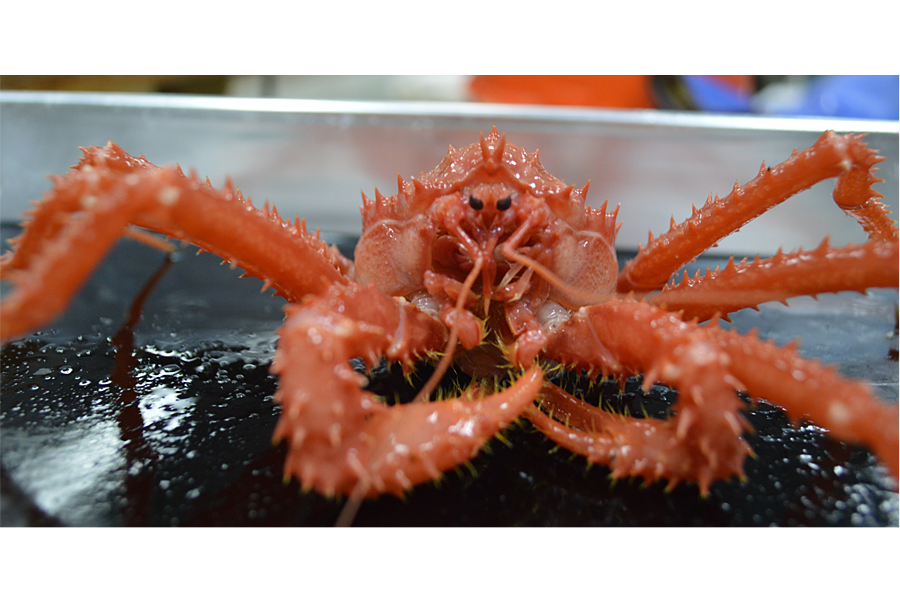How climate change is making Antarctica royally crabby
Loading...
Ocean waters are getting hotter, and that could make Antarctica crabby.
Warming global temperatures are prompting many animals to shift their ranges. One of those animals, the King crab, could be moving into shallower waters off the Western coast of Antarctica, where it hasn't been found for tens of millions of years.
The royal crustaceans, Lithodidae, now live on the continental slope off the western Antarctic Peninsula, a surprise to researchers there. Furthermore, there are no longer temperature barriers preventing the crabs from crawling up onto the continental shelf, according to a study published Monday in the Proceedings of the National Academy of Sciences.
This is bad news for the crab's prey. King crabs, like lobsters, rays, some fish, and modern sharks, hunt by crushing shells, a tactic that Antarctic animals have not evolved a defense against.
“Marine communities in shallow water environments in Antarctica look vastly different from marine communities elsewhere in the world,” says study lead author Richard Aronson, head of the department of biological sciences at Florida Institute of Technology.
“If you were to go to a museum of natural history and look at the dioramas of life in the ancient seas, you’d be looking at something that doesn’t look all that hugely different from what you see in Antarctica today,” says Dr. Aronson. “The Antarctic communities are in a sense archaic or retrograde because they don’t have modern predators in them.”
The Antarctic continental shelf is dominated by filter feeders, marine animals that sit on top of the mud or sand, capturing particles for food, says Aronson. “The top predators in these Antarctic communities are slow moving invertebrates like starfish and giant ribbon worms and giant sea spiders.”
For millions of years these animals have lived without fear of crushing predation. But that could all change.
King crabs, and other shell-crushing predators, were likely driven off the continental shelf by declining temperatures millions of years ago, says Aronson. But “now we’re running the whole thing in rapid reverse by warming the temperatures rapidly.”
The crabs need warmer waters to survive. Right now the crabs have been spotted mostly between 3,600 and 4,900 feet deep on the continental coast, only going as shallow as 2,759 feet deep.
But now it is warm enough for the crabs to survive on the edge of the continental shelf in depths of just 1,300 to 1,800 feet. Aronson expects to see that temperature barrier be pushed to even shallower places as global temperatures continue to rise.
But aren’t shallow waters warmer than the depths? Actually, off the western coast of Antarctica, the opposite is true. Both converging oceanic currents and melting ice close to the surface of the ocean contribute to the chilly shallows.
Furthermore, says Aronson, the waters off this western peninsula are seeing the most dramatic rise in temperature of the region. “It’s basically the bellwether for what’s going to be happening elsewhere in Antarctica,” he says.
The researchers captured pictures of the continental slope to determine how many king crabs lived there. “There were a lot more than a few,” says Aronson. The researchers found about 11,655 crabs per square mile at the most populated areas.
“We know that it’s a dense population and we know that it’s a reproductive population,” he says. The still photographs captured some crabs in what Aronson calls their “copulatory embrace,” as well as some babies and eggs.
The researchers didn’t rely solely on these photographs. They also pulled up a few live crabs to study. By examining the animals’ physiology, they were able to better understand the characteristics needed for king crabs to call an ecosystem home.
Aronson calls the king crabs a threat to a unique community, but the true culprit is global warming, he says. Not only will it bring shell-crushing predators back into this ecosystem, their prey will likely be especially vulnerable as they face other effects of climate change.
“We need to know what we are doing to our world,” Aronson says. “We need to know what’s going on. We need to know the full extent of climate change effects.”
“In this particular case, we’re making some changes that will impoverish our world” by changing unique ecosystems like the one at stake, he says. “If somebody took Michelangelo’s statue of David and threw it in the dumpster, would you care about it?”
“This is all about what we care about in our lives,” says Aronson. “We need to make some choices.”








